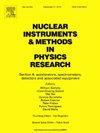Preformed plasma waveguides: Enabling high-energy electron beams for FLASH radiotherapy
IF 1.4
3区 物理与天体物理
Q3 INSTRUMENTS & INSTRUMENTATION
Nuclear Instruments & Methods in Physics Research Section A-accelerators Spectrometers Detectors and Associated Equipment
Pub Date : 2025-07-29
DOI:10.1016/j.nima.2025.170891
引用次数: 0
Abstract
This study explores the use of preformed plasma waveguides, such as dielectric capillaries, for laser-plasma accelerators (LPAs) to generate 250 MeV very high-energy electron (VHEE) beams for FLASH radiotherapy (FLASH-RT). These beams enable the delivery of ultra-high-dose radiation (UHDR) while minimizing damage to healthy tissue. This method is highly effective in laser wakefield acceleration (LWFA), where a laser pulse accelerates electrons to high energies. Pre-ionizing the plasma with a high-voltage supply before the main pulse improves plasma uniformity and optimizes laser-plasma interaction, leading to more efficient and stable acceleration. The resulting uniform plasma enhances beam quality by reducing energy spread and instabilities, essential for UHDR delivery within a short time frame. VHEE beam production will be enabled by a table-top system at the upcoming I-LUCE (INFN-Laser indUCEd Radiation Production) facility in Catania, Italy, which is advancing toward FLASH-RT. Plasma formation in capillary plasma waveguides is simulated using COMSOL Multiphysics, while Monte Carlo (MC) simulations evaluate the absolute dose delivered to a water phantom during multi-beam irradiation with VHEE beam. Meanwhile, the feasibility of achieving FLASH conditions is discussed.
预成形等离子体波导:为FLASH放射治疗提供高能电子束
本研究探索了使用预成形等离子体波导,如介电毛细管,用于激光等离子体加速器(LPAs)产生250 MeV的高能电子束(VHEE),用于FLASH放射治疗(FLASH- rt)。这些光束能够提供超高剂量辐射(UHDR),同时最大限度地减少对健康组织的损害。该方法在激光尾流场加速(LWFA)中非常有效,其中激光脉冲将电子加速到高能量。在主脉冲前用高压电源预电离等离子体,提高了等离子体的均匀性,优化了激光与等离子体的相互作用,从而提高了加速效率和稳定性。由此产生的均匀等离子体通过减少能量扩散和不稳定性来提高光束质量,这对于在短时间内提供超高dr至关重要。VHEE光束的生产将由即将在意大利卡塔尼亚的I-LUCE (infn激光诱导辐射生产)设施的桌面系统实现,该设施正在向FLASH-RT发展。使用COMSOL Multiphysics模拟了毛细管等离子体波导中的等离子体形成,而蒙特卡罗(MC)模拟评估了在VHEE光束的多束辐照过程中传递给水模体的绝对剂量。同时,讨论了实现FLASH条件的可行性。
本文章由计算机程序翻译,如有差异,请以英文原文为准。
求助全文
约1分钟内获得全文
求助全文
来源期刊
CiteScore
3.20
自引率
21.40%
发文量
787
审稿时长
1 months
期刊介绍:
Section A of Nuclear Instruments and Methods in Physics Research publishes papers on design, manufacturing and performance of scientific instruments with an emphasis on large scale facilities. This includes the development of particle accelerators, ion sources, beam transport systems and target arrangements as well as the use of secondary phenomena such as synchrotron radiation and free electron lasers. It also includes all types of instrumentation for the detection and spectrometry of radiations from high energy processes and nuclear decays, as well as instrumentation for experiments at nuclear reactors. Specialized electronics for nuclear and other types of spectrometry as well as computerization of measurements and control systems in this area also find their place in the A section.
Theoretical as well as experimental papers are accepted.

 求助内容:
求助内容: 应助结果提醒方式:
应助结果提醒方式:


